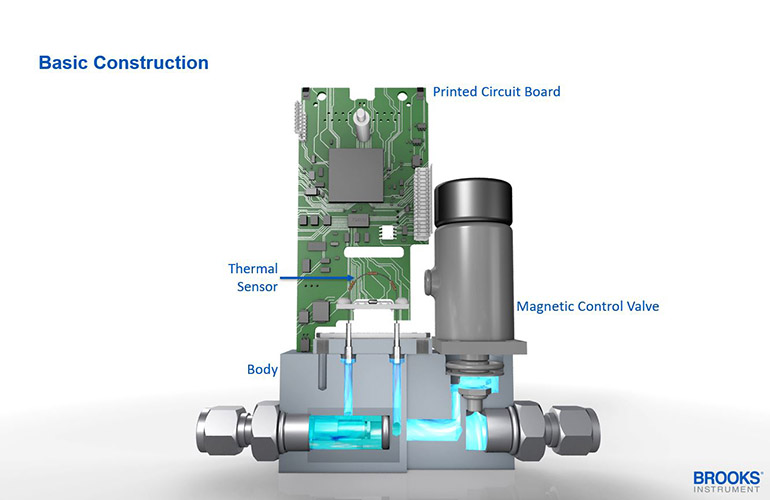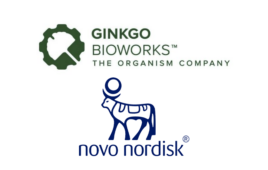Exercising greater process control and delivering improved yields are constant challenges for bioprocessing operations. Here’s how mass flow controllers help.
Joe Sipka, Brooks Instrument

While the accuracy of an MFC when it’s first installed is important, repeatability references how well that accuracy is maintained over hundreds of hours of operation — and is an equally important specification. [Image courtesy of Brooks Instrument]
Role of MFCs in bioreactors
MFCs play an essential role in maintaining a bioreactor’s controlled environment and achieving optimal cell growth. Two critical factors that govern cell culture yield are the levels of dissolved oxygen (DO) in the bioreactor and the pH of the fermentation broth.
Tight control of dissolved oxygen is achieved by using the MFC to enrich the airflow with oxygen, or by depleting it with nitrogen. In turn, maintaining the proper levels of DO regulates cell growth and reduces the production of toxic cell by-products.
Tight control of pH with carbon dioxide flow is also critical. Some bioreactor processes introduce acids and bases to achieve the desired pH level, but this approach is often too harsh for the delicate mammalian cells involved in bioprocessing. Using carbon dioxide (CO2) to tightly control pH levels has been found to be a more effective approach.
Understanding basic functionality of thermal mass flow controllers
Although different manufacturers configure their MFCs to specific designs, four essential MFC functional subsystems are:
- Body/Restrictor: The body and restrictor manage gas flow through the mass flow controller. The restrictor diverts a small sample of incoming gas to a thermal sensor. A well-designed restrictor creates a constant flow ratio across the full operating range with different gasses.
- Sensor: The thermal sensor is the heart of the MFC. It accurately detects temperature differences to determine the mass flow rate based upon the properties of the specific gas being transmitted.
- Control Valve and Drive: The integral gas flow control valve ensures accurate control throughout the full gas flow range. The valve drive supports diagnostics and can be indicative of device performance and reliability.
- Electronics/Firmware: The electronics process and scale the sensor signal, compare the sensor signal to the setpoint signal, modulate the gas flow and provide a digital output that accurately depicts the gas flow rate.

The four essential MFC functional subsystems are shown here. [Image courtesy of Brooks Instrument]
For bioprocessing applications, some MFC manufacturers are also choosing to use elastomer seals that comply with stringent industry safety requirements, such as the USP (United States Pharmacopeia) Class VI classification. Class VI is the most stringent and requires multiple tests to verify the lowest level of toxicity and certifies that there are no harmful reactions or ill effects caused by chemicals contained in the plastic.
Current digital MFCs have a number of specifications and features that process scientists and engineers should consider when selecting MFCs for their systems and operations. They include:
Accuracy: Gas flow rates cover a scale: An MFC’s ability to accurately perform across a full range of flow rates is key to assuring accurate operation of the MFC. An MFC, for example, needs to be able to start at zero and going up to 200 slpm and back down again, while maintaining stability and repeatability.
Repeatability: While the accuracy of an MFC when it’s first installed is important, repeatability references how well that accuracy is maintained over hundreds of hours of operation and is an equally important specification. When a specific flow rate is used repeatedly in rapid succession without changing conditions, the distribution of the flow measurement data points indicates the MFC’s repeatability. The best performing MFCs are engineered to extremely tight stability levels. For example, a well-performing MFC might need zero stability of <0.2% full scale per year.
Turndown/rangeability: In MFCs, the turndown ratio, also referred to as rangeability, indicates the range in which an MFC can accurately measure process gas delivery. MFCs that can be field-configured to handle a broader range of flows — for example, a turndown ratio of 250:1 — help maximize production uptime, eliminating the need to replace a lower flow rate MFC with a higher flow rate MFC at critical production junctures.
Multi-gas MFCs: With the advent of digital MFCs, settings for multiple gases can now be stored on a single device, rather than a separate MFC for each gas. Multi-gas MFCs offer significant savings. Instead of changing out four different MFCs for different sized systems — one each for Air, CO2, N2 and O2 — each time there is a change of gases, a single MFC configuration on the shelf is all that is required, potentially reducing the number of required MFC configurations by up to 90%.
These savings can be substantial: fewer components need to be ordered, configured and integrated into the bioprocessing system initially, and the end-user can significantly reduce the number of spare MFCs needed for inventory purposes. Changing over from one gas to another is also made significantly easier with a digital command, reducing bioreactor downtime and simplifying operations.
Digital communications interfaces: Many MFCs now feature high-speed Ethernet-based communications, such as EtherNet/IP and EtherCat. These protocols enable sophisticated, real-time interaction and control between the bioreactor controllers and digital instrumentation. These advantages include:
- Ethernet-based protocols which are non-proprietary and future-proof, supported by multiple automation solution providers;
- Seamless communication with industry-leading bioreactor control systems;
- Compliance with Ethernet standards provides a variety of network speeds to choose from — e.g., 10, 100 Mbps and 1 Gbps —giving operators the ability to monitor real-time performance and network data;
- A flexible network architecture that is compatible with standard Cat 5 cabling and routers simplifies network setup and ensures all devices on the network communicate and exchange data with each other.
Improving bioprocessing performance with MFC datasets
The best digital MFCs feature alarms and diagnostic tools to give more complete insight into the quality and efficiency of bioprocessing systems. With a digital MFC, process scientists and engineers can read the flow, totalized flow, temperature, valve drive and other variables simultaneously—and that information is communicated to the bioprocessing control systems or other devices on the network for further action, in real time.
One type of useful MFC diagnostic data is flow totalizer diagnostics. Digital MFCs track and deliver continuous and cumulative flow output into the bioreactor. They also generate alarms if total gas delivery exceeds or falls below preset thresholds. This allows process managers to track process gas delivery and correlate it with predicted flow; that data, in turn, can be integrated into an overall analysis of bioreactor process yield, to assess whether modifying vital gasses, such as O2 or CO2 is warranted.
MFCs: Delivering bioprocessing control and rich data
MFCs provide a critical function in bioprocessing systems: the correct flow of process gases, at key points during an upstream process run, can directly impact bioreactor quality and yield. And by using MFCs engineered to deliver long-term, repeatable and accurate gas delivery, bioprocessing operations can conduct processing runs of highly valuable biologics with confidence that their production and yields will not vary due to variations in gas flows.
Process scientists, intent on bringing to market important new drugs safely and as quickly as possible, can also use the rich data generated by digital MFCs to assess how modifying gas flows can potentially improve yields.
For bioprocessing engineers, who focus on optimizing performance, controlling costs and satisfying strict regulatory requirements digital MFCs provide a key tool for managing specific bioreactors as well as overall bioprocessing system performance, reducing unscheduled downtime and maximizing integrity tester and bioreactor uptime and yields.
Joe Sipka is global business development manager at Brooks Instrument (Hatfield, Pa.).





Joe’s article gives a nice summary of many of the most important aspects for engineers concerned with flow control for bioreactors. I might point out that there are ways of doing this that don’t reply on thermal technology, however. Some of these newer methods can offer dramatic differences in performance, allowing for engineers to take even bigger advantage of some characteristics like turndown or repeatability. It’s not a topic that gets enough love 🙂
How can one adjust the molecular weight on the unit that has a potentiometer on the controller and does this require preplacing an orifice in these units as well?